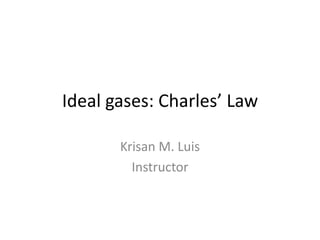
3 charles law
- 1. Ideal gases: Charles’ Law Krisan M. Luis Instructor
- 2. Objectives • To describe the behavior of ideal gases – To understand the following gas laws • Boyle’s Law • Charles’ Law • Avogadro’s Law – To understand the ideal gas equation – To apply the above concepts on real life situations
- 3. Kinetic Theory of Gases The particles in gases • Are very far apart • Move very fast in straight lines until they collide • Have no attraction (or repulsion) • Move faster at higher temperatures
- 4. Charles’ Law V = 125 mL V = 250 mL T = 273 K T = 546 K Observe the V and T of the balloons. How does volume change with temperature?
- 5. Charles’ Law: V and T At constant pressure, the volume of a gas is directly related to its absolute (K) temperature V1 = V2 T1 T2
- 6. Variation of gas volume with temperature at constant pressure. Charles’ Law V T V = constant x T V1/T1 = V2 /T2 Temperature must be in Kelvin T (K) = t (0C) + 273.15 5.3
- 7. Learning Check GL3 Use Charles’ Law to complete the statements below: 1. If final T is higher than initial T, final V is (greater, or less) than the initial V. 2. If final V is less than initial V, final T is (higher, or lower) than the initial T.
- 8. Solution GL3 V1 = V2 T1 T2 1. If final T is higher than initial T, final V is (greater) than the initial V. 2. If final V is less than initial V, final T is (lower) than the initial T.
- 9. A sample of carbon monoxide gas occupies 3.20 L at 125 0C. At what temperature will the gas occupy a volume of 1.54 L if the pressure remains constant? V1 /T1 = V2 /T2 V1 = 3.20 L V2 = 1.54 L T1 = 398.15 K T2 = ? T1 = 125 (0C) + 273.15 (K) = 398.15 K T2 = V2 x T1 V1 = 1.54 L x 398.15 K 3.20 L = 192 K 5.3
- 10. V and T Problem A balloon has a volume of 785 mL on a Fall day when the temperature is 21°C. In the winter, the gas cools to 0°C. What is the new volume of the balloon?
- 11. VT Calculation Complete the following setup: Initial conditions Final conditions V1 = 785 mL V2 = ? T1 = 21°C = 294 K T2 = 0°C = 273 K V2 = _______ mL x __ V1 K = _______ mL K Check your answer: If temperature decreases, V should decrease.
- 12. Learning Check GL4 A sample of oxygen gas has a volume of 420 mL at a temperature of 18°C. What temperature (in °C) is needed to change the volume to 640 mL? 1) 443°C 2) 170°C 3) - 82°C
- 13. Solution GL4 A sample of oxygen gas has a volume of 420 mL at a temperature of 18°C. What temperature (in °C) is needed to change the volume to 640 mL? 2) 170°C T2 = 291 K x 640 mL = 443 K 420 mL = 443 K - 273 K = 170°C
- 14. Gay-Lussac’s Law: P and T The pressure exerted by a confined gas is directly related to the temperature (Kelvin) at constant volume. P (mm Hg) T (°C) 936 761 691 100 25 0
- 15. Learning Check GL5 Use Gay-Lussac’s law to complete the statements below: 1. When temperature decreases, the pressure of a gas (decreases or increases). 2. When temperature increases, the pressure of a gas (decreases or increases).
- 16. Solution GL5 1. When temperature decreases, the pressure of a gas (decreases). 2. When temperature increases, the pressure of a gas (increases).
- 17. PT Problem A gas has a pressure at 2.0 atm at 18°C. What will be the new pressure if the temperature rises to 62°C? (V constant) T = 18°C T = 62°C
- 18. PT Calculation P1 = 2.0 atm T1 = 18°C + 273 = 291 K P2 = ? ? T2 = 62°C + 273 = 335 K What happens to P when T increases? P increases (directly related to T) P2 = P1 x T2 T1 P2 = 2.0 atm x K = K atm
- 19. Learning Check GL6 Complete with 1) Increases 2) Decreases 3) Does not change A. Pressure _____, when V decreases B. When T decreases, V _____. C. Pressure _____ when V changes from 12.0 L to 24.0 L (constant n and T) D. Volume _____when T changes from 15.0 °C to 45.0°C (constant P and n)
- 20. Solution GL6 A. Pressure 1) Increases, when V decreases B. When T decreases, V 2) Decreases C. Pressure 2) Decreases when V changes from 12.0 L to 24.0 L (constant n and T) D. Volume 1) Increases when T changes from 15.0 °C to 45.0°C (constant P and n)
